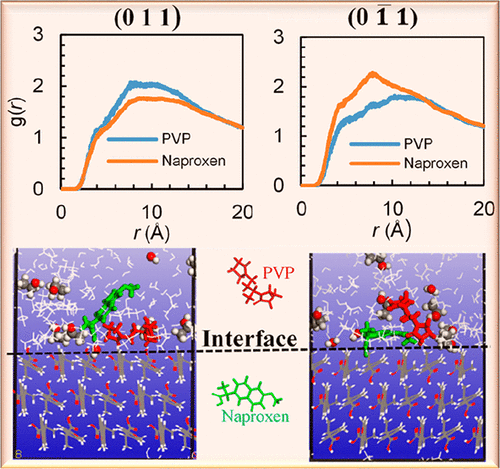当前位置:
X-MOL 学术
›
Cryst. Growth Des.
›
论文详情
Our official English website, www.x-mol.net, welcomes your
feedback! (Note: you will need to create a separate account there.)
Atomistic Simulation To Understand Anisotropic Growth Behavior of Naproxen Crystal in the Presence of Polymeric Additives
Crystal Growth & Design ( IF 3.2 ) Pub Date : 2019-06-03 00:00:00 , DOI: 10.1021/acs.cgd.9b00193 Krishna M. Gupta 1 , Yin Yani 1 , Sendhil K. Poornachary 1 , Pui Shan Chow 1
Crystal Growth & Design ( IF 3.2 ) Pub Date : 2019-06-03 00:00:00 , DOI: 10.1021/acs.cgd.9b00193 Krishna M. Gupta 1 , Yin Yani 1 , Sendhil K. Poornachary 1 , Pui Shan Chow 1
Affiliation

|
Polymeric additives can either inhibit or promote the growth of a crystal. While crystal growth inhibition by additives/impurities has been widely documented, the molecular-level mechanisms by which additives promote crystal growth are largely elusive. In this study, we use molecular dynamics simulations to model the interactions among a polymeric additive (polyvinylpyrrolidone), solute (naproxen), and solvent (ethanol/water mixture) molecules occurring at the crystal/solution interface. At the (01̅1) surface, solvent interactions with the crystal surface and solute molecules are diminished in the presence of the additive, thereby lowering the solvation barrier to crystal growth. Besides, the interaction of solute molecules with this surface is enhanced, leading to crystal growth promotion along the −b axis. On the contrary, the additive preferentially interacts with the (011) face and the solute–solvent interaction is stronger at this crystal face. These two factors lower the adsorption rate of solute molecules onto this face and consequently retard crystal growth along the +b direction. Further, in the presence of the additive, mobility of the solute is slowed down at the (01̅1) face (supports the promotion event); in contrast, at the (011) face, the solute exhibits a larger mobility (supports the inhibition event). The simulation results, while providing insights into the anisotropic growth behavior of naproxen crystals in the presence of polymeric additives, have implications on the selection of additives for crystallization inhibition in pharmaceutical and agrochemical formulations, as well as for modulation of undesired crystal shapes to enable better downstream processing.
中文翻译:

高分子添加剂存在下萘普生晶体各向异性生长行为的原子模拟
聚合添加剂可以抑制或促进晶体的生长。尽管已经广泛地证明了添加剂/杂质对晶体生长的抑制作用,但添加剂促进晶体生长的分子级机理在很大程度上尚不清楚。在这项研究中,我们使用分子动力学模拟来模拟发生在晶体/溶液界面的聚合物添加剂(聚乙烯吡咯烷酮),溶质(萘普生)和溶剂(乙醇/水混合物)分子之间的相互作用。在(01̅1)表面,在存在添加剂的情况下,溶剂与晶体表面和溶质分子的相互作用会减少,从而降低了对晶体生长的溶剂化势垒。此外,溶质分子与该表面的相互作用得到增强,从而促进了沿-b的晶体生长轴。相反,添加剂优先与(011)面相互作用,并且溶质-溶剂相互作用在该晶体面上更强。这两个因素降低了溶质分子在该面上的吸附速率,因此阻碍了晶体沿+ b的生长。方向。此外,在存在添加剂的情况下,溶质的迁移率在(01 face1)面上变慢(支持促进事件);相反,在(011)面上,溶质表现出更大的迁移率(支持抑制事件)。模拟结果在洞悉聚合物添加剂存在下萘普生晶体的各向异性生长行为的同时,对药物和农用化学品配方中抑制结晶的添加剂以及不希望的晶体形状进行调制以实现更好的添加剂具有影响。下游处理。
更新日期:2019-06-03
中文翻译:

高分子添加剂存在下萘普生晶体各向异性生长行为的原子模拟
聚合添加剂可以抑制或促进晶体的生长。尽管已经广泛地证明了添加剂/杂质对晶体生长的抑制作用,但添加剂促进晶体生长的分子级机理在很大程度上尚不清楚。在这项研究中,我们使用分子动力学模拟来模拟发生在晶体/溶液界面的聚合物添加剂(聚乙烯吡咯烷酮),溶质(萘普生)和溶剂(乙醇/水混合物)分子之间的相互作用。在(01̅1)表面,在存在添加剂的情况下,溶剂与晶体表面和溶质分子的相互作用会减少,从而降低了对晶体生长的溶剂化势垒。此外,溶质分子与该表面的相互作用得到增强,从而促进了沿-b的晶体生长轴。相反,添加剂优先与(011)面相互作用,并且溶质-溶剂相互作用在该晶体面上更强。这两个因素降低了溶质分子在该面上的吸附速率,因此阻碍了晶体沿+ b的生长。方向。此外,在存在添加剂的情况下,溶质的迁移率在(01 face1)面上变慢(支持促进事件);相反,在(011)面上,溶质表现出更大的迁移率(支持抑制事件)。模拟结果在洞悉聚合物添加剂存在下萘普生晶体的各向异性生长行为的同时,对药物和农用化学品配方中抑制结晶的添加剂以及不希望的晶体形状进行调制以实现更好的添加剂具有影响。下游处理。































 京公网安备 11010802027423号
京公网安备 11010802027423号